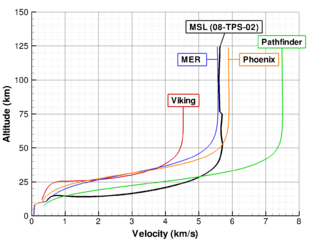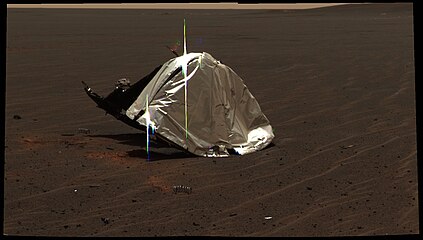Mars atmospheric entry

Mars atmospheric entry is the entry into the atmosphere of Mars. High velocity entry into Martian air creates a CO2-N2 plasma, as opposed to O2-N2 for Earth air.[1] Mars entry is affected by the radiative effects of hot CO2 gas and Martian dust suspended in the air.[2] Flight regimes for entry, descent, and landing systems include aerocapture, hypersonic, supersonic, and subsonic.[3]
Overview
[edit]Thermal protection systems and atmospheric friction have been used historically to reduce most of the kinetic energy that needs to be lost prior to landing, with parachutes and, sometimes, a final bit of retropropulsion used in the final landing. High-altitude high-velocity retropropulsion is being researched for future transport flights landing heavier cargos.
For example, Mars Pathfinder entered in 1997.[4] About 30 minutes prior to entry, the cruise stage and entry capsule separated.[4] When the capsule hit the atmosphere it decelerated from about 7.3 km/s to 0.4 km/s (16,330 mph to 900 mph) over three minutes.[4] As it descended the parachute opened to slow it down further, and soon after the heat shield was released.[4] During entry a signal was relayed back to Earth, including semaphore signals for important events.[4]
-
Comparison of altitude (y-axis) and velocity (x-axis) of various Mars landers
-
Parachute of Phoenix lander open as it descends in the Martian atmosphere. This picture was taken by the Mars Reconnaissance Orbiter with HiRISE
-
MSL heat shield
-
MER-B's discarded heat shield on the surface of Mars.
List of spacecraft
[edit]- Mars 2 (1971) – entered atmosphere but crashed
- Mars 3 (1971) – entered atmosphere, soft landed, lost after 20 seconds of data transmission from the surface
- Mars 6 (1973) – entered atmosphere but crashed
- Viking 1 (1976) – successfully landed
- Viking 2 (1976) – successfully landed
- Mars Pathfinder (1997) – successfully landed
- Beagle 2 – lost, confirmed landed but derelict in 2015
- MER-A "Spirit" – successfully landed
- MER-B "Opportunity" – successfully landed
- Mars Polar Lander (lost)
- Deep Space 2 (lost)
- Phoenix lander – successfully landed
- Mars Science Laboratory (Curiosity rover) – successfully landed
- Schiaparelli EDM lander (lost)
- InSight lander (2018) – successfully landed
- Mars 2020 (Perseverance rover and Ingenuity helicopter) – successfully landed
- Tianwen-1 lander and remote camera and Zhurong rover – successfully landed
Technologies
[edit]A deployable decelerator like a parachute can slow down a spacecraft after a heat shield.[5] Typically a Disk-Gap-Band parachute has been used, but another possibility are trailing or attached inflatable entry devices.[5] Inflatable types include sphere w/ fence, teardrop w/ fence, isotensoid, torus, or tension cone and attached types include isotensoid, tension cone, and stacked toroid blunted cone.[5] Viking Program era researchers were the true pioneers of this technology, and development had to be restarted after decades of neglect.[5] Those latest studies have shown that tension cone, isotensoid, and stacked torus may be the best types to pursue.[5]
Finland's MetNet probe may use an expandable entry shield if it is sent.[6] Martian air can also be used for aerobraking to orbital velocity (aerocapture), rather than descent and landing.[1] Supersonic retro-propulsion is another concept to shed velocity.[7]
NASA is carrying out research on retropropulsive deceleration technologies to develop new approaches to Mars atmospheric entry. A key problem with propulsive techniques is handling the fluid flow problems and attitude control of the descent vehicle during the supersonic retropropulsion phase of the entry and deceleration. More specifically, NASA is carrying out thermal imaging infrared sensor data-gathering studies of the SpaceX booster controlled-descent tests that are currently, as of 2014[update], underway.[8] The research team is particularly interested in the 70–40-kilometer (43–25 mi) altitude range of the SpaceX "reentry burn" on the Falcon 9 Earth-entry tests as this is the "powered flight through the Mars-relevant retropulsion regime" that models Mars entry and descent conditions,[9] although SpaceX is of course interested also in the final engine burn and lower velocity retropropulsive landing as well since that is a critical technology for their reusable booster development program which they hope to use for Mars landings in the 2020s.[10][11]
Examples
[edit]Mars Science Laboratory
[edit]The following data were compiled for the Mars Science Laboratory (Curiosity rover) by the Entry, Descent and Landing team at the NASA's Jet Propulsion Laboratory. It provides a timeline of critical mission events that occurred on the evening of August 5 PDT (early on August 6 EDT).[12]
| Event | Time of Event Occurrence at Mars (PDT) | Time Event Occurrence Received on Earth (PDT) |
|---|---|---|
| Atmospheric entry | 10:10:45.7 PM | 10:24:33.8 PM |
| Parachute deployment | 10:15:04.9 PM | 10:28:53.0 PM |
| Heat shield separation | 10:15:24.6 PM | 10:29:12.7 PM |
| Rover lowered by the sky crane | 10:17:38.6 PM | 10:31:26.7 PM |
| Touchdown | 10:17:57.3 PM | 10:31:45.4 PM |
Curiosity's EDL team releases a timeline for mission milestones (depicted in this artist's concept) surrounding the landing of the Mars rover.
Landing site identification
[edit]Concept art of a Mars lander as it approaches the surface, illustrating how identifying a safe landing spot is a concern.[13]

See also
[edit]References
[edit]- ^ a b J. Louriero, et al. - "Atmospheric Entry Research at the Plasma Physics Centre" Archived 2011-01-20 at the Wayback Machine
- ^ Haberle, Robert M.; Houben, Howard C.; Hertenstein, Rolf; Herdtle, Tomas (1993). "A Boundary-Layer Model for Mars: Comparison with Viking Lander and Entry Data". Journal of the Atmospheric Sciences. 50 (11): 1544–1559. doi:10.1175/1520-0469(1993)050<1544:ABLMFM>2.0.CO;2. ISSN 0022-4928.
- ^ Development of Supersonic Retro-Propulsion for Future Mars Entry, Descent, and Landing Systems Archived 2012-02-27 at the Wayback Machine (.pdf)]
- ^ a b c d e Mars Pathfinder Atmospheric Entry Strategy - NASA
- ^ a b c d e B. P. Smith, et al. - A Historical Review of Inflatable Aerodynamic Decelerator Technology Development Archived 2012-04-24 at the Wayback Machine
- ^ MetNet EDLS[permanent dead link]
- ^ Hoppy Price - Austere Human Missions to Mars (2009) - JPL
- ^
Morring, Frank Jr. (2014-10-16). "NASA, SpaceX Share Data On Supersonic Retropropulsion: Data-sharing deal will help SpaceX land Falcon 9 on Earth and NASA put humans on Mars". Aviation Week. Retrieved 2014-10-18.
the requirements for returning a first stage here on the Earth propulsively, and then ... the requirements for landing heavy payloads on Mars, there's a region where the two overlap—are right on top of each other ... If you start with a launch vehicle, and you want to bring it down in a controlled manner, you're going to end up operating that propulsion system in the supersonic regime at the right altitudes to give you Mars-relevant conditions.
- ^ "New Commercial Rocket Descent Data May Help NASA with Future Mars Landings, no. 14-287". NASA. 2014-10-17. Retrieved 2014-10-19.
- ^ Musk, Elon (29 September 2017). Becoming a Multiplanet Species. 68th annual meeting of the International Astronautical Congress in Adelaide, Australia (video). SpaceX. Retrieved 2018-01-02 – via YouTube.
- ^ Dent, Steve (29 September 2017). "Elon Musk's Mars dream hinges on a giant new rocket". Engadget. Retrieved 2018-01-02.
- ^ NASA - Timeline Mission Milestones During Curiosity's Landing
- ^ "Exploration Imagery S91-25383". NASA. February 1991. Archived from the original on 2007-08-02.








